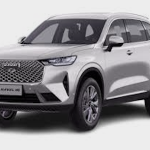Information about Haval H6
Since 2011, the Chinese manufacturer Great Wall Motor producing the compact crossover
Information about Haval H6
known as the Haval H6 . It introduced at the 2011 Shanghai Auto Show.It produced with a drivetrain that was both front-wheel-drive and four-wheel-drive. Originally named Great Wall Haval H6, it later renamed the Haval H6 (and redesigned) for the newly developed Haval brand. It is the successor of the Great Wall Pegasus.
Since its introduction in 2011, the H6 had once led the SUV segment in China for 103 consecutive months, or around 8 years. With 80,495 units sold in December 2016, the H6 set a single-month sales record in the Chinese market . GWM has sold more than four million H6 vehicles worldwide by 2024, making it the company’s best-selling vehicle ever. Information about Haval H6
Features
Either a 1.3-liter turbo engine with 138 horsepower (103 kW; 140 PS) or a 1.5-liter turbo engine with 150 horsepower (112 kW; 152 PS) power the first generation H6. It is possible to get a high-strength body structure, front, side, and curtain airbags, a brake assist system, a tyre-pressure monitoring system, parking sensors and a reversing camera, keyless entry, rain and light sensors, a Bluetooth hands-free system, and a 7-inch touch screen display with a DVD multimedia system on the highest trim level.
Other options include a driver’s seat with 10 adjustment positions, heated front seats, leather seats, climate control with air vents in the rear seats, automatic headlights, a power sunroof, cruise control, and 17-inch aluminum wheels.
>Its power range turbocharged petrol or common rail diesel engines, which are able to meet the Euro V emission standards and can equipped with Start & Stop system.
It has an intelligent four-wheel-drive system, four disk brakes with ABS and EBD, electronic stability control (ESC), independent front suspension with MacPherson struts and independent rear suspension with double cross arm and torsion bar springs, and
It uses components originating from renowned European and American manufacturers, such as Bosch (traction control)Delphi (diesel electronics) BorgWarner (four-wheel-drive system)and Honeywell (turbocharger).
Production
The Haval H6 manufactured at Great Wall Motors’ new Tianjin, China, production facility, which began mass production in February 2011 It assembled at the Litex Motors factory in Bahovitsa, Bulgaria, using knock-down kits from which it exported to other European Union markets.
>In November 2015, approximately four years and three months after its launch, the one millionth Haval H6 left the Tianjin plant’s production lines.
Safety
China-NCAP gave the Haval H6 five stars out of five in a crash test in April 2012 that included three types of collision: a full-wrap frontal collision against a rigid barrier at 50 kilometers per hour (31 miles per hour), a frontal collision with a 40% offset against a deformable barrier at 56 kilometers per hour (35 miles per hour), and a side impact test at 50 kilometers per hour (31 miles per hour).
Reception
In a review of the Italian magazine Al Volante, the Haval H6 appreciated for the comfortable and spacious interior. The rich endowment with features and its low price against the European, Korean and Japanese rivals. It criticized for its relatively sluggish gearbox, the lack of power from the diesel engine at low revs, the rear window visibility and the rigid plastic used in the dashboard.
>It also received praise for its luggage compartment capacity, which ranges from 808 litres (28.5 cu ft) to 2,010 litres (71 cu ft), with the rear seats folded, and is the largest in its size class.
Blue Label, first-generation Haval H6 Coupe
The production version of the Haval Coupe C concept, which debuted at the 2014 Beijing Auto Show, was the Haval H6 coupe, which unveiled at the 2015 Shanghai Auto Show. Despite having slightly smaller dimensions than the standard Haval H6, it ranked slightly higher in the market.
Second generation (2017)
The Haval H6 of the second generation was built on the same foundation as the first-generation model. However, the low-end Haval H6 models from the first generation will continue to be available as a budget model that sits below the second generation. The second generation Haval H6 also shares the same underpinnings of the WEY VV5.
Variants
At launch, the Haval H6 of the second generation was available in two variants with distinct designs for various target market segments, distinguished by the color of the Haval badge. The Haval H6 Blue Label model features a blue Haval badge while the Red Label model has a red Haval badge. The front and back of the H6 Red Label and Blue Label are where they most differ. The front ends are fitted with different grilles, bumpers, and lights. The rear features different tailgate design, bumper design with different mud guards and different pipes. The duo-label strategy was dropped later in 2020 with the logo replaced with a Black label while styling-wise the variant that continued to be available was the previous Red Label model.


